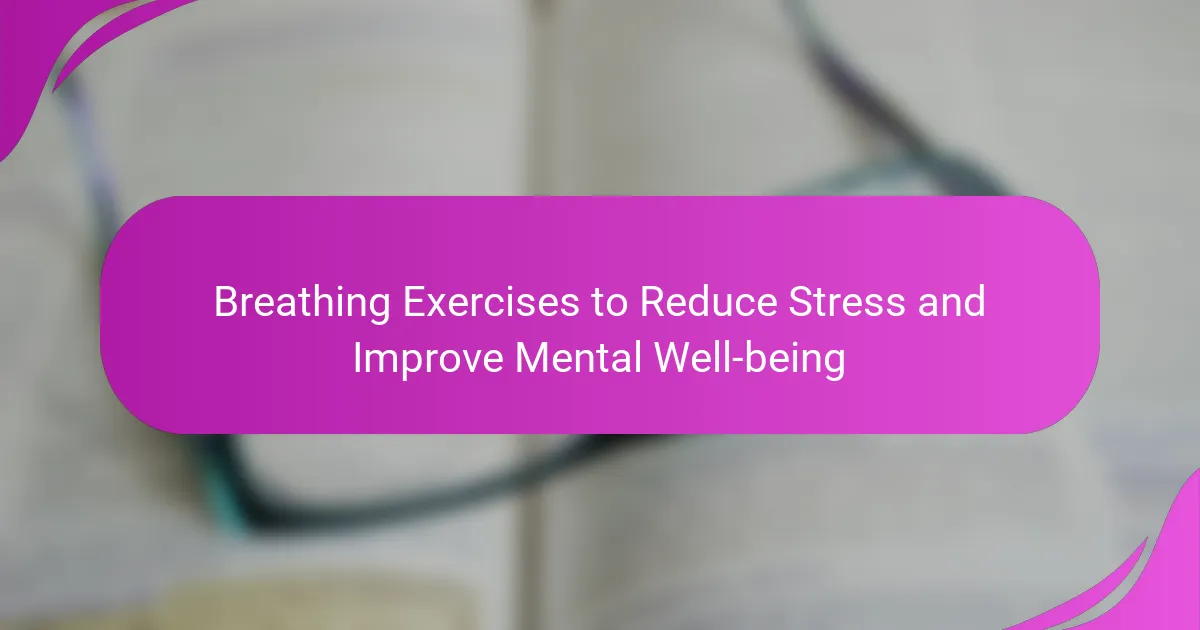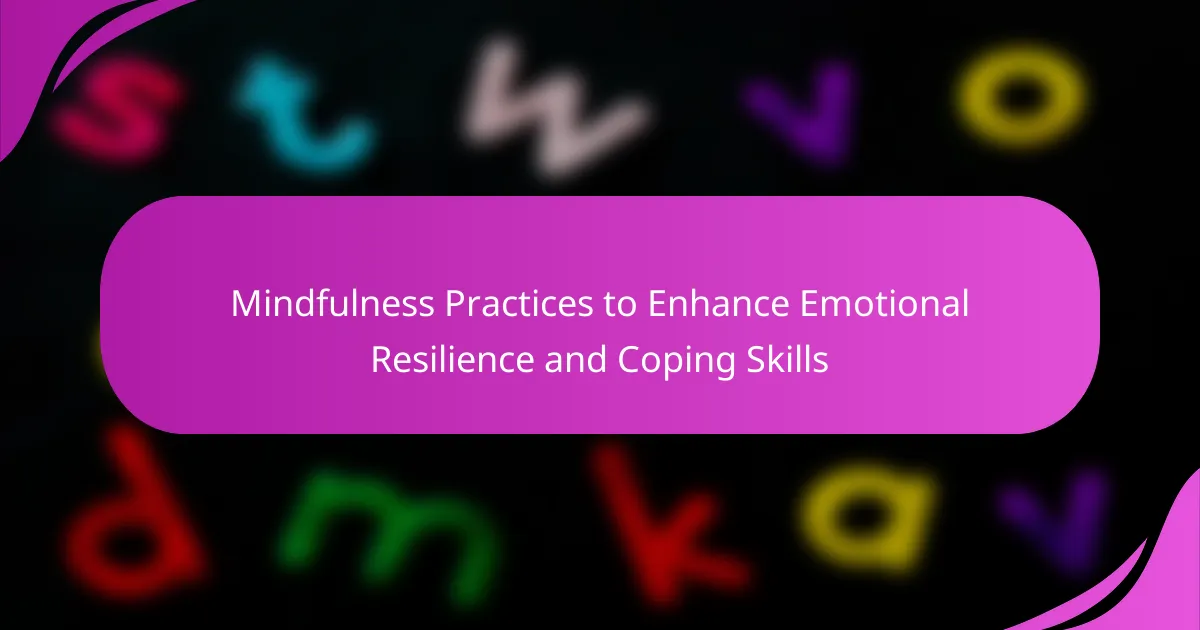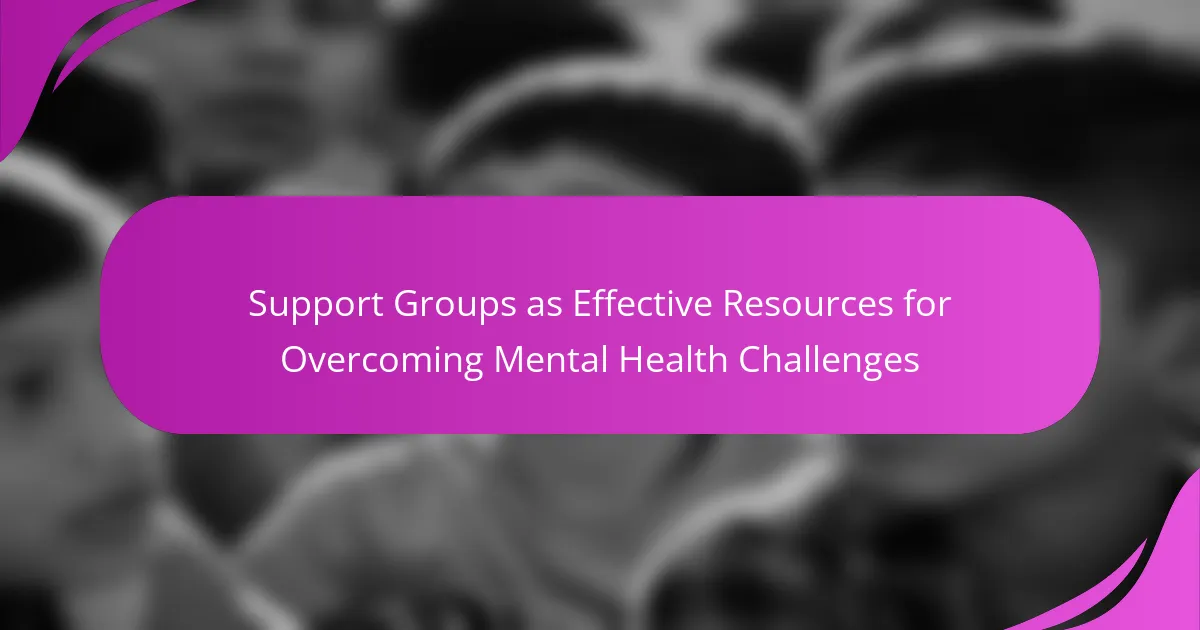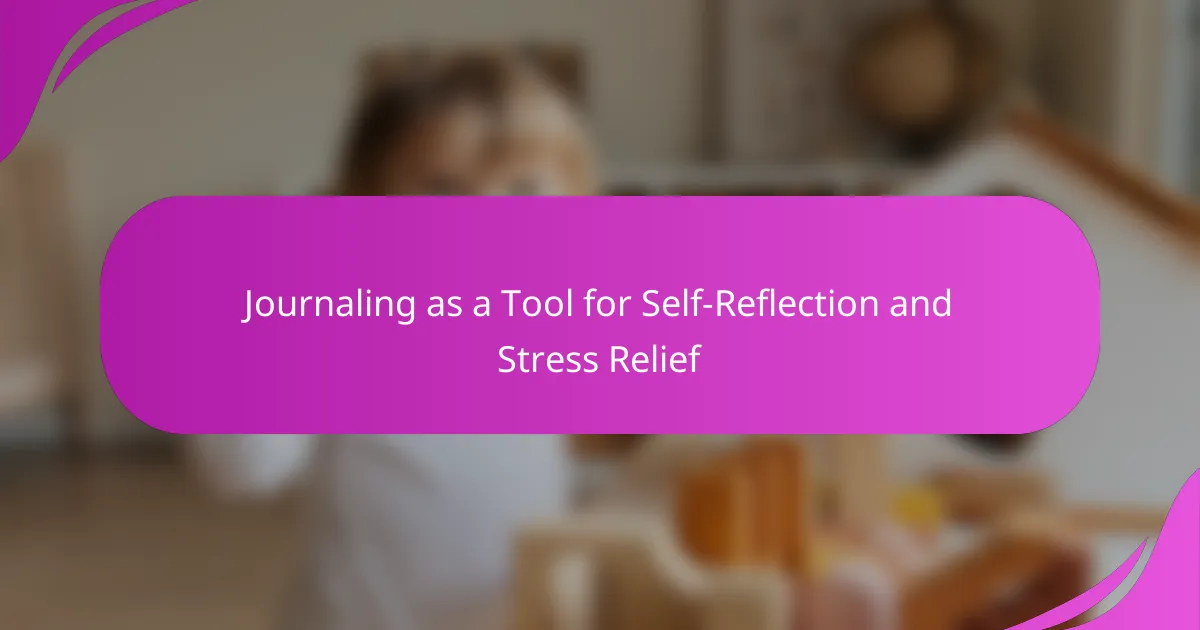Managing anxiety and depression can be challenging, but Cognitive Behavioral Therapy (CBT) offers effective techniques to improve mental health. This article explores key principles like cognitive restructuring and behavioral activation, highlights the benefits of skill-building, and addresses common misconceptions. Additionally, it provides practical strategies for implementing CBT techniques consistently and personalizing them for individual needs.
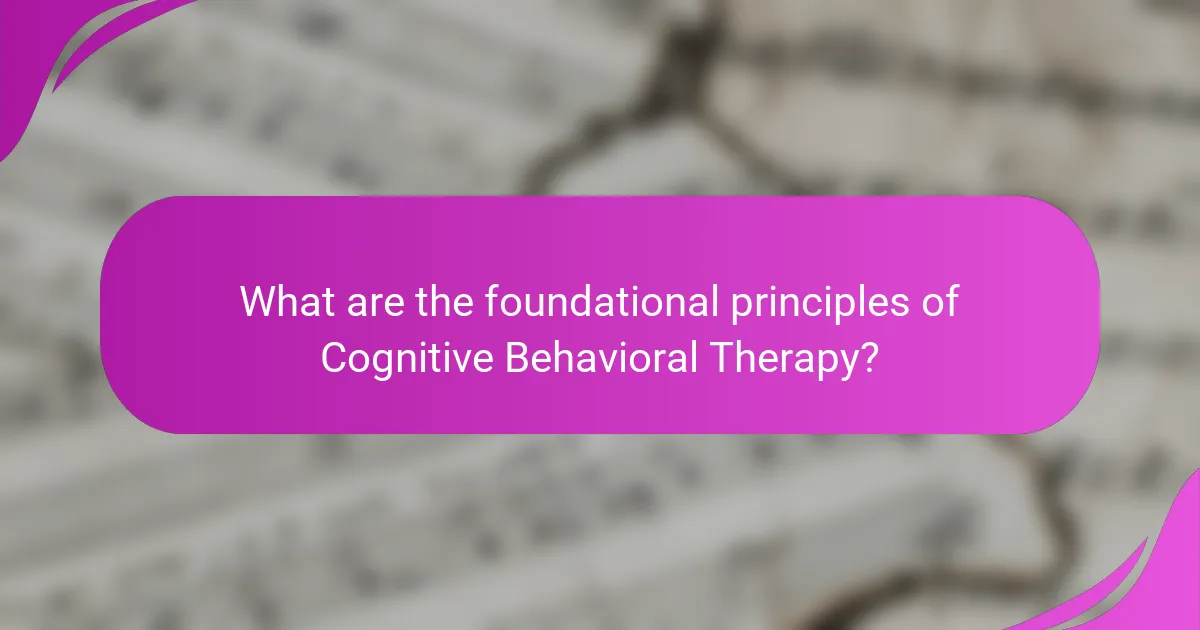
What are the foundational principles of Cognitive Behavioral Therapy?
Cognitive Behavioral Therapy (CBT) is grounded in principles that focus on the connection between thoughts, feelings, and behaviors. These principles include cognitive restructuring, which helps individuals identify and challenge negative thought patterns, and behavioral activation, which encourages engagement in activities to improve mood.
Another key principle is the emphasis on skills training, teaching coping strategies to manage anxiety and depression effectively. The collaborative nature of CBT fosters a strong therapeutic alliance, empowering clients to take an active role in their treatment.
Overall, these foundational principles enable individuals to develop practical tools for managing their mental health.
How does Cognitive Behavioral Therapy address anxiety and depression?
Cognitive Behavioral Therapy (CBT) effectively addresses anxiety and depression by changing negative thought patterns. It employs techniques like cognitive restructuring, exposure therapy, and behavioral activation. These methods help individuals identify and challenge distorted beliefs, gradually face fears, and engage in positive activities. As a result, clients experience reduced symptoms and improved emotional regulation. CBT’s structured approach typically spans 12 to 20 sessions, making it a time-efficient option for many.
What are the key techniques used in Cognitive Behavioral Therapy?
Cognitive Behavioral Therapy (CBT) employs techniques like cognitive restructuring, exposure therapy, mindfulness, and behavioral activation to effectively manage anxiety and depression. These strategies help individuals identify and challenge negative thought patterns, gradually face fears, enhance present-moment awareness, and increase engagement in positive activities. Each technique targets specific symptoms, contributing to overall emotional resilience and improved mental health.
What is cognitive restructuring?
Cognitive restructuring is a technique in cognitive behavioral therapy that helps individuals identify and challenge negative thought patterns. This method promotes healthier thinking by replacing irrational beliefs with more balanced perspectives. It is particularly effective in managing anxiety and depression by enhancing emotional regulation and improving coping strategies.
How does exposure therapy work in CBT?
Exposure therapy in Cognitive Behavioral Therapy (CBT) helps individuals confront fears gradually, reducing anxiety over time. This technique involves controlled exposure to anxiety-provoking stimuli, allowing patients to process their fears in a safe environment. As a result, patients learn coping strategies, leading to diminished avoidance behaviors. Research shows that exposure therapy can significantly improve outcomes for anxiety disorders, with success rates around 60-90% in various studies.
What role do behavioral activation strategies play?
Behavioral activation strategies play a crucial role in Cognitive Behavioral Therapy (CBT) by encouraging engagement in meaningful activities. These strategies help individuals combat feelings of depression and anxiety by breaking the cycle of avoidance and inactivity. By identifying and scheduling positive activities, clients can experience improved mood and motivation. Research shows that regular participation in enjoyable or fulfilling tasks can significantly enhance emotional well-being, making behavioral activation a unique and effective attribute of CBT.
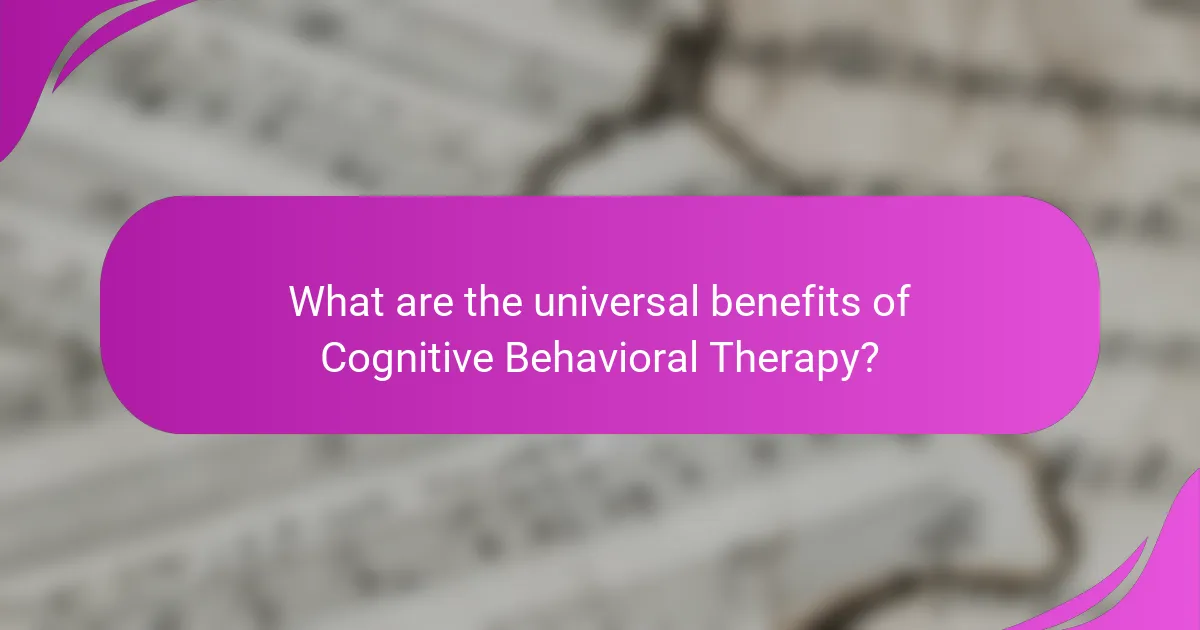
What are the universal benefits of Cognitive Behavioral Therapy?
Cognitive Behavioral Therapy (CBT) offers universal benefits for managing anxiety and depression. It enhances emotional regulation, promotes healthier thinking patterns, and improves coping strategies. CBT’s structured approach enables individuals to identify and challenge negative thoughts, leading to reduced symptoms of anxiety and depression. Research indicates that CBT is effective in achieving long-term improvements in mental health, making it a valuable tool for individuals seeking relief from these conditions.
How effective is CBT for managing anxiety?
Cognitive Behavioral Therapy (CBT) is highly effective for managing anxiety. Studies show that approximately 60-80% of individuals experience significant improvement after completing CBT. This therapy focuses on changing negative thought patterns and behaviors, leading to reduced anxiety symptoms. Additionally, CBT equips individuals with coping strategies, enhancing long-term resilience against anxiety. Its structured approach allows for measurable progress, making it a preferred choice among mental health professionals.
What evidence supports the use of CBT for depression?
Cognitive Behavioral Therapy (CBT) is supported by extensive research for treating depression. Numerous studies indicate that CBT effectively reduces depressive symptoms and enhances overall functioning. For instance, a meta-analysis found that CBT significantly improves outcomes compared to control groups. Additionally, CBT equips individuals with coping strategies, fostering resilience against future depressive episodes. Its structured approach helps clients identify and challenge negative thought patterns, contributing to long-term mental health benefits. Overall, evidence consistently demonstrates CBT’s efficacy in managing depression.
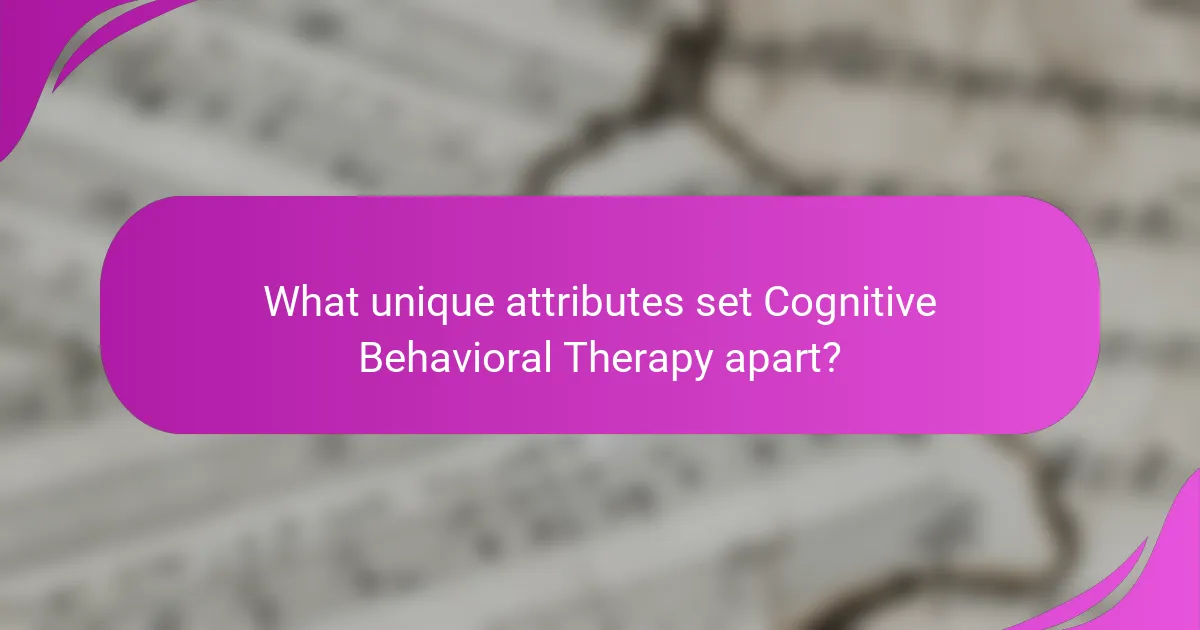
What unique attributes set Cognitive Behavioral Therapy apart?
Cognitive Behavioral Therapy (CBT) is distinguished by its structured approach, focus on present thoughts, and emphasis on skill-building. Unique attributes include its evidence-based techniques, such as cognitive restructuring and exposure therapy, which target specific anxiety and depression symptoms. Additionally, CBT promotes self-monitoring, enabling clients to track their progress and identify triggers effectively. This personalized strategy enhances the therapy’s effectiveness, making it a preferred choice for many mental health professionals.
How does CBT incorporate a structured approach?
Cognitive Behavioral Therapy (CBT) uses a structured approach to effectively manage anxiety and depression. It involves specific techniques such as goal setting, cognitive restructuring, and behavioral activation, which provide clear steps for clients to follow. This structure helps individuals identify and challenge negative thought patterns, fostering healthier thinking and behavior. As a result, clients experience improved emotional regulation and coping strategies. The consistent framework of CBT enhances accountability and progress tracking, making it a valuable therapeutic method.
What is the significance of the therapist-client collaboration in CBT?
Therapist-client collaboration is crucial in Cognitive Behavioral Therapy (CBT) as it enhances treatment effectiveness. This partnership fosters trust, encourages open communication, and allows for tailored interventions. Effective collaboration results in increased client engagement, leading to improved outcomes in managing anxiety and depression. Additionally, clients feel empowered to actively participate in their healing process, reinforcing the therapeutic alliance.
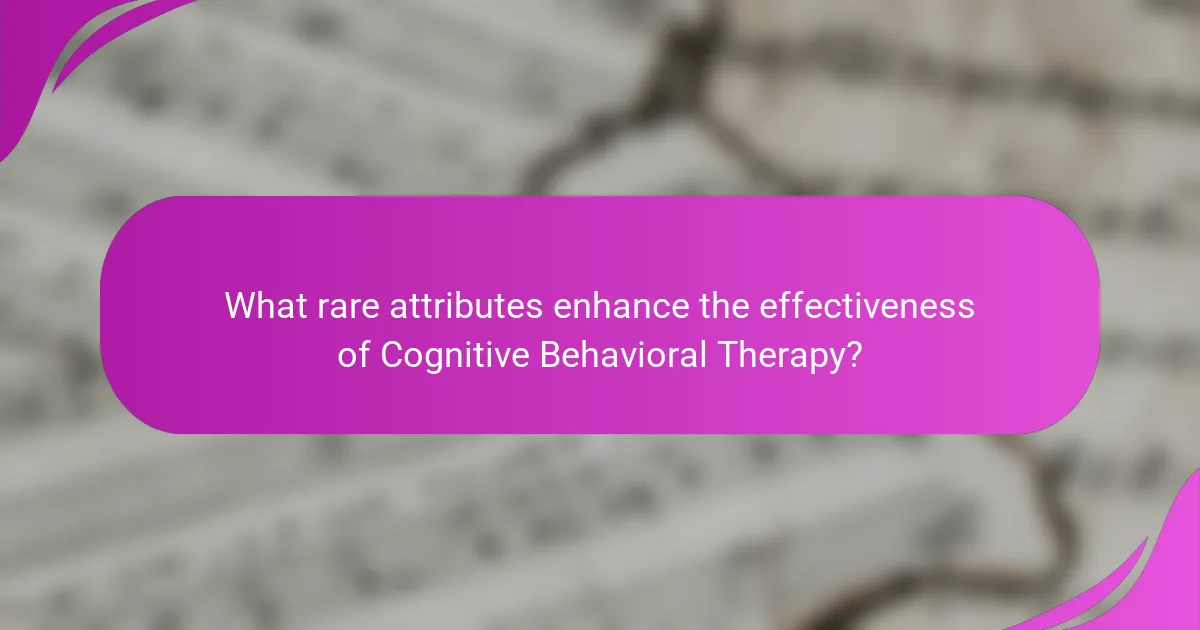
What rare attributes enhance the effectiveness of Cognitive Behavioral Therapy?
Cognitive Behavioral Therapy (CBT) effectiveness is enhanced by rare attributes like personalized treatment plans, integration of mindfulness techniques, and the use of technology for real-time feedback. Personalized plans cater to individual needs, improving engagement and outcomes. Mindfulness techniques help clients develop greater awareness, reducing anxiety and enhancing emotional regulation. Technology, such as apps for tracking progress, provides immediate support and encourages consistency in practice. These attributes contribute to a more tailored and impactful therapeutic experience.
How does the integration of technology improve CBT outcomes?
The integration of technology enhances Cognitive Behavioral Therapy (CBT) outcomes by providing personalized, accessible, and engaging treatment options. Digital platforms enable real-time monitoring of patient progress, which can improve adherence to therapy protocols. For instance, mobile applications facilitate mood tracking and cognitive restructuring exercises, making it easier for individuals to practice skills learned in sessions. Additionally, virtual therapy sessions increase accessibility for those in remote areas or with mobility challenges, ensuring that more people can benefit from CBT techniques. As a result, technology not only supplements traditional methods but also expands the reach and effectiveness of CBT for managing anxiety and depression.
What are the specific adaptations for diverse cultural contexts?
Cognitive Behavioral Therapy (CBT) techniques can be adapted for diverse cultural contexts by considering cultural beliefs, values, and communication styles. Tailoring interventions to respect cultural norms enhances engagement and effectiveness. For instance, incorporating culturally relevant examples during therapy sessions can improve relatability. Additionally, understanding the unique attribute of each culture’s approach to mental health can guide therapists in selecting appropriate techniques. Engaging community leaders and using culturally sensitive language fosters trust and openness in therapy.
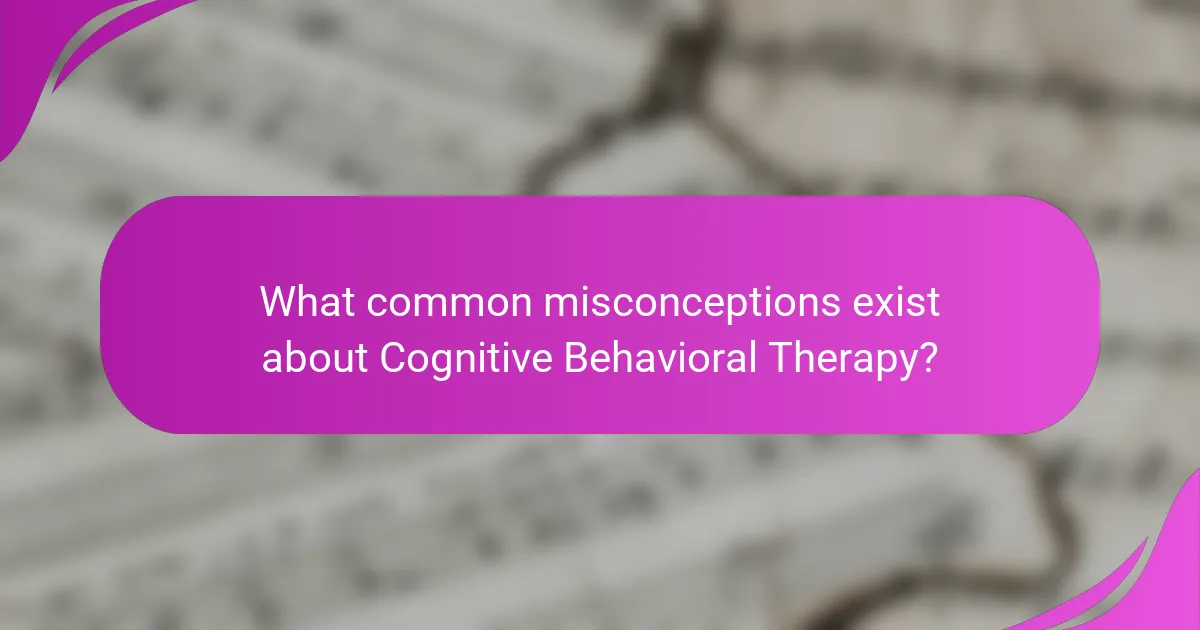
What common misconceptions exist about Cognitive Behavioral Therapy?
Many misconceptions about Cognitive Behavioral Therapy (CBT) can hinder its effectiveness. One common belief is that CBT only focuses on negative thoughts, ignoring underlying issues. In reality, CBT addresses both thoughts and behaviors, promoting actionable change. Another misconception is that CBT is a quick fix; while it can yield rapid results, it often requires consistent practice over time. Additionally, some think CBT is only for severe mental health issues, but it is beneficial for a wide range of conditions, including everyday stress and anxiety. Lastly, people may believe that CBT is solely about talking; however, it incorporates various techniques such as exposure therapy and behavioral activation to manage symptoms effectively.
Is CBT only effective for certain types of anxiety and depression?
Cognitive Behavioral Therapy (CBT) is effective for various types of anxiety and depression. It addresses specific conditions like generalized anxiety disorder and major depressive disorder, but its techniques can also benefit individuals with less common anxiety forms. Research shows that CBT can reduce symptoms across different anxiety disorders, enhancing coping strategies and promoting resilience. Its adaptability makes it a preferred choice in therapeutic settings.
Can anyone practice Cognitive Behavioral Therapy techniques?
Yes, anyone can practice Cognitive Behavioral Therapy techniques with proper guidance. These techniques are designed to be accessible and can be adapted for various individuals. They focus on changing negative thought patterns and behaviors related to anxiety and depression. Resources like self-help books, online courses, and therapy apps can facilitate learning these methods. However, professional support is beneficial for effective application and deeper understanding.

What are the best practices for implementing CBT techniques effectively?
To implement Cognitive Behavioral Therapy (CBT) techniques effectively, focus on consistency, personalization, and gradual exposure. Regular practice of CBT techniques enhances their effectiveness in managing anxiety and depression.
1. Establish a routine: Set specific times for practicing techniques like cognitive restructuring and exposure therapy.
2. Personalize strategies: Tailor techniques to fit individual needs and situations for better engagement.
3. Use journaling: Document thoughts and feelings to identify patterns and track progress.
4. Gradually increase exposure: Start with less anxiety-provoking situations and gradually move to more challenging ones.
These practices ensure a structured approach to utilizing CBT techniques for optimal mental health outcomes.
How can individuals tailor CBT techniques to their personal needs?
Individuals can tailor Cognitive Behavioral Therapy (CBT) techniques by identifying personal triggers and customizing interventions. Start by recognizing specific anxiety or depression symptoms. Next, select techniques that resonate, such as cognitive restructuring or exposure therapy. Regularly assess progress and adjust strategies based on effectiveness. Incorporating personal values and preferences enhances motivation and adherence.
What common mistakes should be avoided when using CBT?
Common mistakes to avoid when using Cognitive Behavioral Therapy (CBT) include skipping homework assignments, misinterpreting cognitive distortions, and neglecting to track progress. Failing to engage fully in the process limits the effectiveness of CBT. Additionally, not personalizing techniques to fit individual needs can hinder outcomes. Lastly, overlooking the importance of a supportive therapeutic relationship may lead to a lack of trust and open communication.
What expert insights can enhance the practice of Cognitive Behavioral Therapy?
Expert insights can significantly enhance Cognitive Behavioral Therapy (CBT) by integrating techniques that address specific anxiety and depression symptoms. Evidence-based practices, such as exposure therapy, help clients confront fears gradually, reducing avoidance behaviors. Mindfulness techniques can improve emotional regulation, allowing clients to stay present and lessen anxiety.
Additionally, incorporating cognitive restructuring enables clients to identify and challenge negative thought patterns, fostering a more balanced perspective. Group therapy sessions provide social support, enhancing motivation and accountability. Regular feedback and progress tracking can further refine therapeutic approaches, ensuring tailored interventions for individual needs.
Ultimately, these insights facilitate a comprehensive and adaptive CBT practice, leading to improved outcomes for clients managing anxiety and depression.
